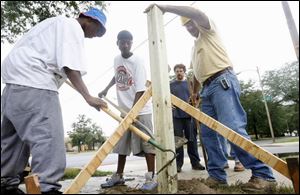
Youth diversion allows judges a range of options
9/23/2007
Working in the CITE program, Nate Lee, left, and DaSHAWN Jones help install a fence for the community garden at TenEyck Tower with help from mentor Brian Haley. Looking on at rear is Brian Zelip, supervisor with Toledo Grows.
It's one of those days that drains you before you get out of bed - stifling, gray, and promising a midday storm.
On 21st Street near downtown Toledo, about a dozen teens scrape and glop fresh cement into postholes around the community garden at TenEyck Tower.
Barely breakfast time, the workers' shirts already stick to skin. But the alternative to building this picket fence is clear: These workers could be locked up instead.
This is the Community Integration and Training for Employment program, one of a menu of 40 programs Lucas County Juvenile Court can use to punish and rehabilitate the county's youngest - and theoretically its most malleable - offenders.
"There's a saying that the art in adult court is in determining guilt or innocence," Lucas County Juvenile Court Magistrate Donna Mitchell said. "In juvenile court, the art is in the sentencing."
Funded by federal grants, state money, and community donations, the programs are designed to divert youths from lockup. The goal is to keep them busy, to make them better decision-makers, and to build mental and physical skills.
There's sex offender treatment, ankle monitors, and family counseling. Treatment Alternatives to Street Crime (TASC) organizes activities like softball games and out-of-town museum trips to help keep young addicts busy. Parents Helping Parents meetings offer assistance to those raising troubled youths.
Treatment Court, for addicted teens and their families, begins with weekly court hearings, random drug screens, and a slew of meetings with counselors, probation officers, and youth workers.
The Toledo Museum of Art offers classes in glass-blowing and metalwork, and Mountain Mentors takes troubled teens to the White Mountains in New Hampshire for grueling hiking and mountain climbing trips.
There's punishment too, pure and simple.
Enter the putty knife.
The court's frequent fliers know what's coming when Judge Denise Cubbon turns to CITE's director, Charlie Johnson, during court and opens with a familiar question: "How's the gum on the sidewalks these days?"
This stifling July day, as thick clouds drag across the sky, the youths are paid about $6.25 an hour. And they've been paired all day with apprentice carpenters and experienced foremen.
"Adolescence is a developmental process and to get through it, you have to do things, not just talk about them or hear about them," Mr. Johnson said.
"It's easy to take those things for granted, like realizing you have to show up for work on time," Mr. Johnson said.
"But these are kids, for one, and some of them are from chaotic lives where no one is really taking charge."
Josh Minnick, 17, is honest: The busywork helps.
Busted the first time with cocaine and a 45-caliber pistol, he's been to lockup several times, he said. But this time, he's not complaining, even in this heat.
"When I go to those programs, I'm learning. If I'm sitting out here I'm going to want to smoke a blunt joint, bowl, bong, something. It's easy: Keep me busy, I'm not going to use."
It's weeks later, and the fence is completed. Nate Lee, 16, continues to work for CITE these days, in part because he sees more than a paycheck and a way to keep busy.
"It's something for the community. I've seen homeless people walking through there."
He's considering a career in carpentry now. Plus, he took his mom to see the fence. She told him she was impressed, he said.